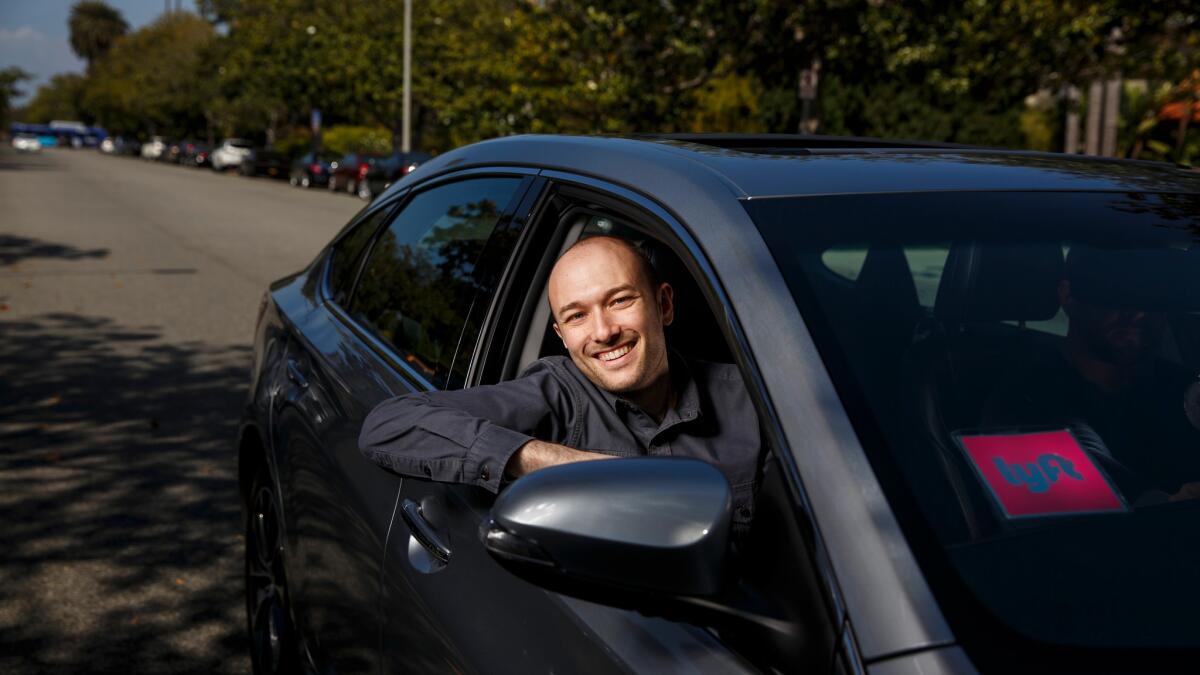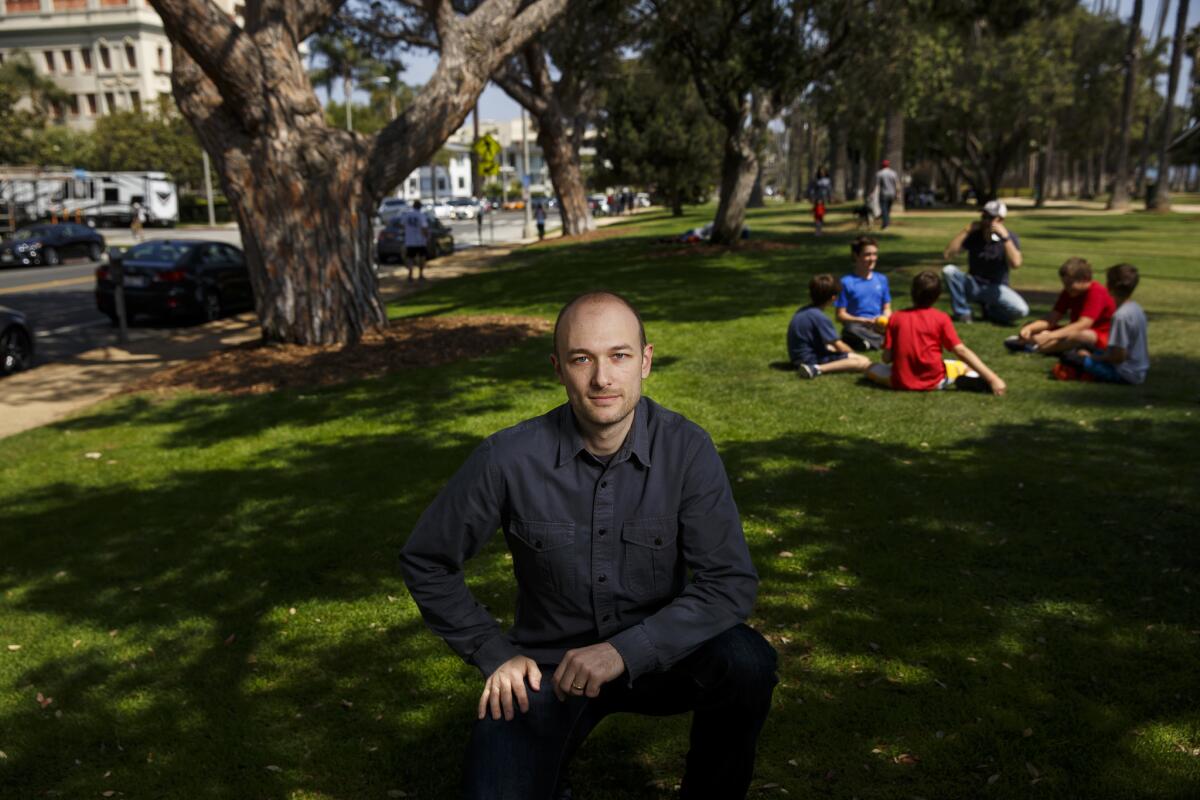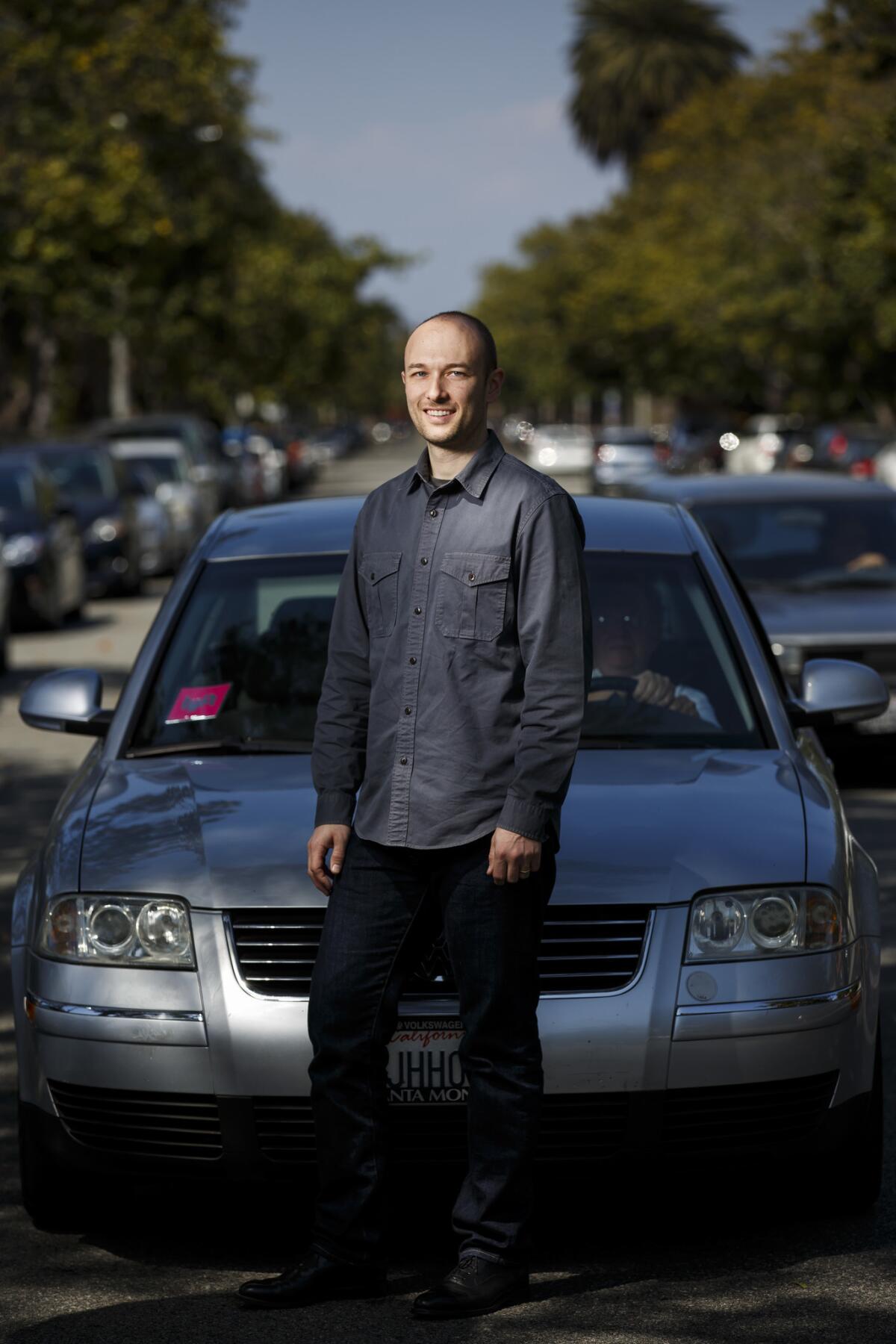Lyft CEO Logan Green has a plan that’s far bigger than ride-hailing

- Share via
Logan Green applied for his first job out of college by submitting a resume and a document titled “Logan’s Life Plan.”
It was a grandiose heading, especially for a 22-year-old angling for what was a junior role as sustainability coordinator at UC Santa Barbara. But the plan itself was more wonkish than ostentatious. Absent were typical life goals: owning a nice house, taking lavish vacations, starting a huge, successful company.
Instead, it called for creating a sustainability newsletter, serving on transportation and greenhouse gases subcommittees, and getting funding so the university could put solar panels on dorm roofs.
“He definitely stood out,” said Marc Fisher, UCSB’s vice chancellor of administrative services, who hired Green for the role more than 10 years ago. “Especially for his age, he had a lot of poise, and the combination of his intellect and social capacity was extremely unusual.”
Green, co-founder and chief executive of the ride-hailing company Lyft, had always been obsessed with making the world cleaner, greener and more efficient, said Matt Van Horn, a friend of Green’s since high school.
SIGN UP for the free California Inc. business newsletter >>
"Transportation was a big one for him," Van Horn said. "He was a power user of public transportation. He's one of the only people I know who knew how to take a bus in L.A."
When Green left Culver City for college at UCSB he also left behind his 1989 Volvo 740.
“I wanted to absorb all the alternatives to car ownership,” he said. “My hope was to come up with a transportation solution that didn’t require everybody to own a car like L.A. does.”
Green talks about this with the tone someone might use to order a sandwich. He made giving up his car sound like it was no big deal.
“But it was crazy,” Van Horn said. After all, what kind of 18-year-old native Angeleno does that?
Growing up in Culver City, Green learned to sit in traffic — first in the car seat, then in the back seat, then, when he got his license, in the driver’s seat.
Traffic was all anyone around him seemed to talk about. It was a fact of life, the trade-off for year-round sunshine in one of the most lively cities in America.
But for Green, this wasn’t good enough. Why did it have to be this way? What if people just gave up their cars? What if it started with him?
Now 32, he runs a company that plans to do away with car ownership, first by getting commuters to share rides, then eventually by having fleets of self-driving cars offer carpools at a the tap of a button.
It’s an ambitious plan that has drawn big bucks from investors, including $500 million from General Motors that brought the company’s valuation to $5.5 billion.
But Green’s company doesn’t just traffic in world-saving ideals. If it will survive, it must eventually turn a profit. Green is adamant that Lyft will find a way to do so on its own terms — as a socially responsible company.
“That’s one of the things that keeps me up at night,” Green said.
In the tech world, where companies sink millions of dollars into creating a brand identity, Lyft has cast itself as the friendlier, more thoughtful ride-hailing company.
It’s an image born in part from the firm’s relentless marketing efforts. Its “Your friend with a car” slogan is plastered on billboards, bus stop signs, and online ads.
But it’s also born from Green himself, according to people who have known him since middle school.
Green was the kid who transcended social circles. He played ice hockey with the jocks, but also loved science and taught himself to code. He was the sweet kid, the calm kid, the 8th-grade kid who asked his parents to move the family TV into the garage because he thought it was too distracting.
He was also a product of his home: the son of a veterinarian and doctor who composted and recycled before it was cool, who regaled him with stories of helping organize farm labor unions, who biked the 350 mile trail from L.A. to Mono Lake as part of a campaign to save the lake.
And where most kids sat in L.A. traffic sighing and groaning, Green was plotting and scheming, always asking what if, what if, what if?
As soon as he got to college, finding an alternative to car ownership became a mission he continues to obsess over today.
At UCSB he helped the campus fund-raise for a new bike lane. He convinced the university to donate six cars to a car-sharing program, similar to Zipcar, so students on campus could leave their cars at home, too.
His enthusiasm for buses and car sharing caught the attention of the Santa Barbara City Council, which appointed him to its Metropolitan Transit District’s board of directors. He became its youngest-ever member.
“He walked in bright-eyed and bushy-tailed. He was a quick learner, very collaborative, always smiling,” David Davis, chairman of the SBMTD said. “Although I see he’s lost his hair since he left us.”

Green joined the board with huge ambitions for the public transit system. If the MTD could get more funding, from higher fares or taxpayer revenue, it could add more services, extend existing lines, and bring the city a step closer to doing away with car ownership.
But his three years on the board were an education in the economic and political pressures public systems face. When the board tried to increase fares, the public pushed back. When the board put a measure on the ballot to increase taxes, voters defeated it.
He learned that while people said they supported public transit, few were willing to pay for it. This left the district locked in place.
This also meant Green couldn’t count on the public sector to accomplish his mission.
The concept of sharing a ride isn’t new. Many U.S. cities have some form of casual carpooling program. But the problem is not enough people do it.
What if, Green wondered, people whose cars were already on the road could charge a fare in exchange for giving others a ride? More bottoms in seats meant fewer cars on the road, which means less congestion, less pollution and, ultimately, a changed world.
During a post-college trip to Zimbabwe, he’d seen ordinary Zimbabweans do this, so he knew it worked. Maybe he could replicate it, make it work for Americans.
This was the beginning of Zimride, a Facebook app he built that let people take long-distance carpools with each other.
Zimride’s early investors recall making a bet on Green and fellow co-founder John Zimmer because of their mission, and also because of the enormous business opportunity Zimride presented.
In their original pitch presentation, Green and Zimmer talked about changing the way people travel, encouraging carpools, doing away with solo drivers. And, yes, taking a big piece of the trillion-dollar U.S. transportation pie.
“Doing the math, even if these rides they were doing were only a couple percentage points of all transportation, it was huge,” said Rajil Kapoor, a former board member and investor in Zimride. “Logan and John knew they had to pitch this as a massive business first. And they did.”
But there was a problem. In 2007 no one had a smartphone. Coordinating rides over Facebook was cumbersome. And demand for long-distance rides was low.
The breakthrough didn’t come until nearly five years later when they experimented with Lyft. With smartphones and GPS systems now ubiquitous, Green and Zimmer launched a separate app in which ordinary people could offer rides in their cars on demand — no need to go through a Facebook Web application.
Whether or not they knew at the time, moving into on-demand peer-to-peer ride-hailing pulled the trigger on a ruthless race.
Logan as a leader and person grew up in wartime. From the outset, Uber just went after them.
— Scott Weiss, partner at Andreessen Horowitz
Back in 2012, Uber was only a black town car service. “But we knew [Uber CEO] Travis [Kalanick] and his team could turn on a dime, so we had to move fast,” Kapoor said.
Uber launched its own peer-to-peer ride-hailing product, UberX, a month later.
At first, Lyft and Uber had more differences than similarities.
Lyft was a service that let ordinary people book or offer rides — a casual arrangement in which strangers felt welcome in the front seat and greeted each other with fist bumps. With its whimsy pink mustache logo, Lyft cultivated a friendly public image, backed up by low-profile founders who regularly hopped behind the wheel and offered rides themselves.
Uber was a luxury service offering limousine-style comfort and on-demand convenience. It lived up to its lofty name with its high-end service and rapid expansion, establishing a reputation for brashness as it flouted local regulations, lashed back at critics and openly clashed with the taxi industry.
But as Lyft and Uber fought each other to recruit passengers and drivers, the competition led them to march in lockstep.
When Lyft promised to debut its carpooling feature, Uber stole its thunder by announcing its own carpooling feature a day earlier. When Uber lowered its fares in Los Angeles and San Francisco to attract passengers, Lyft followed. Uber launched fare-splitting in 2013. Lyft did the same in 2014. Both companies have accused each other of sabotaging their operations by booking and canceling thousands of rides.
“I don’t know if I’ve been part of a company that has had such a tough competitor,” said Scott Weiss, a partner at Andreessen Horowitz, which invested in Lyft. “From the outset, Uber just went after them. Logan as a leader and person grew up in wartime. It was just one emergency after another, and after a while he became like a field general.”
Having to change strategies on the fly to keep up with the competition can be frustrating, but Weiss believes it has also made both companies better. And for Green’s part, he’s never lost his sandwich-ordering calmness.

“He’s not grizzled, smoking a cigarette, complaining about Uber,” said John Siegel, a close friend from high school who introduced Green to Zimmer. “He and John are very thoughtful, strategic people. They’re focused on something that’s bigger than Uber.”
Which isn’t to say that the threats facing the company aren’t real. Uber is 10 times the size of Lyft with more money, more drivers and more customers. And thanks to a deal that hands over the Chinese market to rival Didi Chuxing, Uber will have an extra $1 billion a year to steer toward other markets or projects — or deploy against its rivals.
“Lyft might have to be content with the markets it’s in, or maybe try to get acquired by General Motors,” said Ajay Chopra, a partner at Trinity Ventures, which has not invested in Uber or Lyft.
GM and Lyft have partnered to develop and, eventually, distribute autonomous vehicles. Neither Lyft nor GM have publicly talked about acquisition ambitions, but more and more analysts believe it’s the only way for Lyft to take on Uber.
Or Lyft and GM could get to self-driving cars first, giving them the advantage over every ride-hailing company.
Zimmer told The Times he believes Lyft can provide a full alternative to car ownership over the next 5 to 10 years.
It’s an eyebrow-raising statement, but also “totally in the realm of possibility,” particularly given GM’s resources,said Karl Brauer, an analyst with Kelley Blue Book.
If that happens, Lyft will have to transition from a company that “treats drivers better,” to one that has no drivers. But it’s “not going to happen overnight,” Zimmer said.
Until that day comes, venture capitalists and gig economy experts believe Lyft’s best bet lies in differentiating itself.
Lyft’s investors say the company’s ideology matters because millennials — the largest demographic in the U.S. — care more than previous generations about what a business stands for.
But as Lyft’s and Uber’s offerings have become nearly identical (last month, Lyft even rolled out a luxury “premier” line), those differences may prove harder for drivers and passengers to spot.
“The two are essentially the same,” said Douglas Cordero, 36, who drives part-time for Uber and Lyft. “The only difference is the Lyft app has a tipping feature.”
Cordero said both companies have cut driver rates to the point where they struggle to make a living. Neither have offered any worker protections or employee benefits. And both have been slapped with (and are in the process of settling) class-action lawsuits that accuse them of misclassifying drivers as independent contractors — a classification that means drivers can’t unionize.
Green declined to comment on the ongoing litigation, but acknowledged that neither employee or independent contractor categories are a perfect fit for what the drivers do. He said the company has lowered fares to remain price competitive. And as ride-hailing becomes commoditized, the company has tried to be the better platform for drivers, taking a smaller commission from those who drive full-time, and to date paying out more than $100 million in tips.
Lyft investors acknowledge that some of the company’s idealism has given way to pragmatism.
All Lyft drivers once had to mount fluffy pink mustaches on their cars. Now they use modest pink stickers. Passengers now sit wherever they want, and fist bumps are less common. Green and Zimmer used to interview every driver in person. They’ve handed that job over to driver mentors.
“Obviously, they’ve relaxed as they’ve expanded to new cities and realized they were competing for drivers,” Weiss said. “But their idealism still carries forward today.”
Green didn’t accomplish everything in his Life Plan during his time at UCSB. But the university held on to the document long after he left.
Ten years on, UCSB is now installing solar panels on dorm roofs, just like Green had laid out. The processes he created for how students can submit funding proposals and the organization’s bylaws are still in use today.
“So Logan’s Life Plan apparently turned into our life plan,” Fisher of UCSB said.
With one life plan behind him, now he begins another.
In this plan, he’ll have to navigate Lyft through challenges both personal and existential. There’s the ongoing lawsuits from disgruntled drivers. There’s the competition from a cashed-up Uber. There’s the race to self-driving cars.
And if all that goes right, there’s that dream of weaning the world off car ownership and solving that traffic problem once and for all.
Green acknowledges it’s a “crazy long shot.”
Like his Life Plan, if the dream is fulfilled, there’s a chance it might happen well after both he and Lyft are gone. But he hopes it happens on his watch.
Twitter: @traceylien
ALSO
Olympics bans most brands from saying 'Olympics' or 'Rio,' even on Twitter. Snark ensues
TMZ wins legal battle with Starline Tours, deputies raid tour bus offices to collect cash




